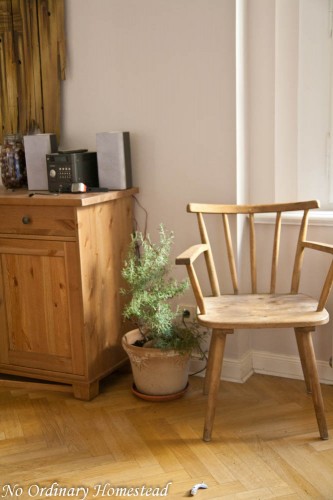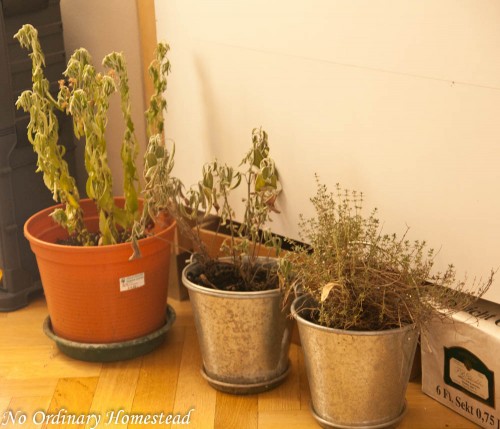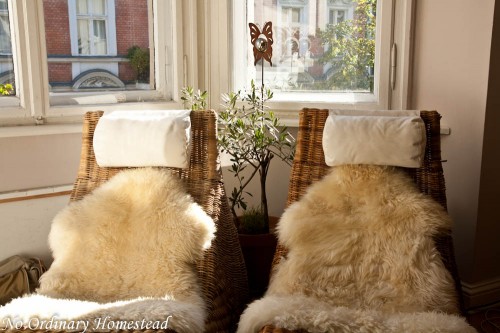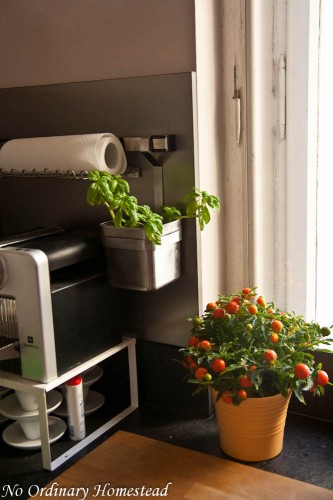Yesterday I decided it was time to bring my plants in from the balcony. Since everything we have here with us is in pots, it’s a pretty simple process. Well, actually, I left the strawberries outside for now because we’re about to have a really nice warm front for the next few days, but chances are I will bring them in at some point also just so they don’t get too cold during the long winter.
As I was placing the plants around the apartment and glanced at them the rest of the day, I realized I’m actually kinda thrilled with where some of them are and how they look. So I may not put them back outside next spring…most of them don’t care that much either way, although the rosemary does usually seem to like being back outside at some point since it gets a bit of mold as spring approaches.
What you need to know
- Timing — It can depend on the plant, but generally when you’re seeing temps below 60°F for 3+ days in a row, you want to bring plants that are not winter hard inside.
- Bugs — Do a general survey to see if there are any sort of spiders, meal worms, centipedes or other unwanted house guests on the plants before you bring them inside. Make sure you also look in water trays below the plants for hitch hikers. The same goes with any sort of pests that can harm your plants. If you bring them inside, your plants will be in closer proximity to each other so the likelihood of spreading scales or other pests will be higher.
- Clean up — If your plants have been outside for a while, the pots are likely to be a bit dirty and grungy. So take a few minutes before you plan to move them inside to scrub down your pots briefly and get them looking nice.
- Keep only the healthy ones— If your plants have already been looking sickly or suffering, chances are they are going to get worse when you bring them inside because they’ll go into shock. So save yourself the sorrow if it’s just a random plant and toss it before you go to the trouble of moving it indoors.
- Upgrading — If any of your plants will need to be repotted, do it a few days in advance of the move to give the plants time to adjust
- Fertilizing — Plants are generally going to grow a bit less in the winter because the amount of light they receive (even with your indoor lights nearby) is generally less. So you should usually cut back if not completely cease fertilizing.
- Watering — Remember that most plants are not going to dry out quite as quickly now that the are indoors, so in many cases, watering once a week will be plenty. But keep an eye on plants near a heating source since they may need more frequent attention.
- Lighting — Give a little bit of thought to the amount of sun your windows will allow your plants to receive. Plants that need full sun should be put near south-facing windows and those requiring only partial sun can go in front of an east- or west-facing window. If need be, you can also get a plant light where the light is just not sufficient for your plants, and these are usually low wattage which means they’ll be inexpensive to run.
All this decorating with plants has made me crave having more of them! I did get a delightful little plant from a friend for my birthday — but we have such big wide, open spaces in our apartment now, I think I’m going to have to convince Stefan to go to the home improvement store soon and see if they have some good closeouts in the gardening department for the end of the season! 😉
Featured Posts from Last Week’s Natural Life Linky
Let’s talk about these great mindful eating tips. I’m totally guilty of rushing through my food. It got worse when I became a mom…and now that we’re running, I’m hungry All. The. Time! 🙂
Want to join in the fun and link to your own blog? You can share about anything related to natural living, from gardening to recipes to home remedies to anything else related to natural living.
Here’s how this works:
PLEASE READ THESE GUIDELINES, especially if you have never linked up before!
Posts you might want to link up could include:
- Green & natural living
- Real Food recipes
- Repurposing & upcycling ideas and projects
- Home remedies & aromatherapy
- Gardening goodness
- Sustainable smartness
- And other things related to living a more natural life
Here’s how this works:
- You are free to join the Natural Living link up at any time. You can also skip a few weeks and then come back. It’s entirely up to you.
- Please do not share more than 2 links per Link-up. If you do, I will delete the “extras.”
- Please link directly to the specific post on your blog that relates to green living — not your main blog URL.
- Please only link to your own blog or photos hosted online.
- Link back to No Ordinary Homestead or the Natural Living link up post in your blog post. This way, if someone else wants to join the fun, they can. You can either link with text or using the Natural Living badge. Below is a code for the badge above – feel free to resize it as you need. Just copy and paste this code into your post or save and upload the image to your blog: <a href=”https://www.noordinaryhomestead.com/category/natural-living/natural-living-link-up/“><img title=”natural living link up″ src=”https://www.noordinaryhomestead.com/wp-content/uploads/2012/08/noh-natural-living-linky.jpg” alt=”natural living link up” width=”300″ /></a>
- I highly encourage you to visit other participants and leave comments. This is a great way to meet new friends and become inspired about your garden! I try to visit all the blogs participating as well every week

That’s it! Share your green ideas with us by linking up at the bottom of this week’s Natural Living post!
That’s it! Share your garden with us by linking up below!









My spider plants hate coming in for the winter. So I’m giving them a couple more weeks. They are so nice and green outside but get pale once they’re hanging in the window. Guess they are Southerners at heart! [email protected]
Thanks for the link up, our focus is on natural living as well so it’s great to read other likeminded sites. I did just want to give you a heads up that the link in your email takes you to another post, not the plant one.